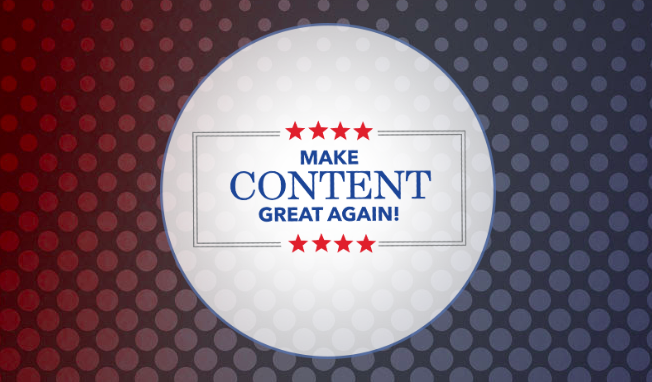Love it or hate it, election season impacts us all. This election season in particular, we’ve seen a tremendous shift in how people exercise their free speech and support their candidates.
The current election cycle has influenced the Content4Demand team so much that we’ve designed an entire event theme and campaign around it.
A tongue-in-cheek reference to one of America’s more scandalous candidates, our “Make Content Great Again” campaign rings true to where we are in the marketing world and what Content4Demand strives to achieve — as individuals and as a team.
As marketers, we’re in the midst of a crisis of sorts. Content has been commoditized. Companies of all sizes and across industries are ramping up their content investments, building out content teams, hiring brand journalists and implementing new tools and solutions.
Sure, 51% of buyers say they rely more on content to research buying decisions than they did a year ago. But 60% of B2B marketers say their top challenge is producing engaging content, according to research from MarketingProfs and the Content Marketing Institute.
What’s the problem here? A few things come to mind and have inspired our “Make Content Great Again” campaign…
Marketers are focusing on speed more than strategy. Marketers are focusing so much time, effort and money on churning out content as quickly as possible. This is great and all, but the fact is that companies are just creating as many product briefs, case studies, white papers and blogs as they can without asking the right (and at times difficult) questions up front, such as:
- What are my buyers thinking about?
- What are their most pressing needs?
- What keeps them up at night?
- What kind of content resonates with them?
- What do they need to learn to do their jobs better?
Don’t walk blindly into the chaos. Answer these questions to develop a content marketing foundation that you can build up and scale over time. It’s so much more efficient (and less stressful) than planning on a quarterly basis.
Marketers are scared to break the content rules. Research studies and analyst reports have preached to the content marketing masses over the years, sharing their imperatives for a successful content strategy.
It’s great to use data to guide your plans or validate your decisions. But have you noticed that we sometimes pigeonhole ourselves by treating these thought-leadership insights as marketing gospel? One example is content format decisions. Infographics are for top of the funnel, E-books and white papers are mainly for the middle of the funnel and case studies are optimal for the bottom of the funnel. Lather, rinse, repeat. Before you know it, you’re stuck in the same cycle of content creation and promotion.
Although buying stage definitely plays a role in your format decisions, your buyers and their preferences should be your priority. Also take into account your messaging points. What are you trying to say with this piece? What are the key takeaways, trends or best practices? How do they help your buyers answer important questions or address their challenges in each specific stage of the buyer’s journey? Finally, which content format will help you convey these insights and tell your story effectively? When you answer these questions, you will come to the right content format for your needs and goals – and if that means a late-stage infographic or a first-touch video, so be it!
Marketers are not pushing the creative limits. Bombarded by executive team pressure, quarterly/annual goals and looming deadlines, we as marketers do whatever it takes to create the content we need to generate demand. Sometimes that means sticking to what we know, what we’re comfortable with, what our team will approve and what we know can be turned around quickly. As a result, our “lather, rinse, repeat” content creation process comes back to haunt us.
There are so many new content formats and platforms available to help you tell your story in new, more compelling ways. Rather than releasing another static infographic, add a layer of interactivity! Pop-ins and animations can make your story and data more dynamic, and can even allow you to share more insights and best practices, despite having less real estate with which to do so. Motion graphics, video demos and executive video interviews can also breathe new life into product briefs, research studies and case studies — assets that are extremely detailed and sometimes dense.
You don’t have to reallocate your entire budget to these interactive formats, and you certainly don’t need to hire a whole new team of interactive designers and coders. Start small by focusing on one or two projects. Integrate them into a campaign and see how they perform by tracking clicks, downloads and reach across your promotional channels. From there, you should have a good idea of how to move forward.
Whether in our personal or professional lives, change can be a scary thing. But we can work together to make content great again! Are you ready to stand with us? Join the conversation by tweeting us with the hashtag #MakeContentGreatAgain. If you’re at the SiriusDecisions Summit in Nashville this week, visit booth #536, chat with our team and vote on your top content format for the year!




